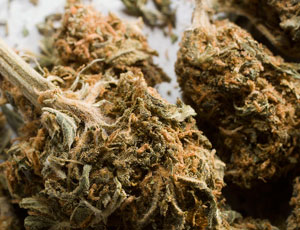What is marijuana?
Marijuana is a mind-altering drug produced by the cannabis sativa plant. It is the most commonly used illegal drug in the United States. Marijuana is grown in the U.S., Canada, Mexico, South America and Asia. Marijuana contains over 480 constituents including THC (delta-9-tetrahydrocannabinol). THC is believed to be the main psychoactive effect producing ingredient.
Common names include Bud, Blunts, Chronic, Dope, Ganja, Grass, Herb, Hydro, Indo, Mary Jane, Pot, Reefer, Sinsemilla, Skunk, Smoke and Weed.
What does marijuana look like?
Marijuana is a dry, shredded mix of flowers, stems, seeds and leaves. The mixture typically is green, brown or gray in color and may resemble tobacco. Marijuana smoke has a distinct, sweet-and-sour, odor.
How is marijuana abused?
Marijuana is commonly smoked in cigarette/joint form, a pipe, bong or blunt (a cigar emptied of tobacco and refilled with marijuana). Marijuana can also be mixed with foods or brewed as a tea. Vaping is another method for consuming marijuana. Most often, e-cigarettes are used to heat the oils or extracts of marijuana and then inhaled. Dabbing is the newest method of inhalation involving “dabs” containing elevated levels of THC to achieve an intense high sometimes resulting in immediate incapacitation.
How does marijuana affect a person?
THC connects to specific sites called cannabinoid receptors on nerve/brain cells and affects the activity of those cells. These receptors influence pleasure, memory, thought, concentration, sensory/time perception and coordinated movement.
Marijuana causes impairments in learning, associative processes, judgment and driving abilities. Behavioral effects include dizziness, nausea, tachycardia, facial flushing, dry mouth, tremors, merriment, happiness, exhilaration, relaxation, increased sociability and talkativeness. Increased appetite and short-term memory loss are also common.
Many states have legalized marijuana to treat pain and nausea caused by HIV/AIDS, cancer and other conditions; however, clinical evidence has not yet shown the therapeutic benefits outweigh the health risks.
What are the health effects/risks of using marijuana?
Marijuana causes serious health problems such as bronchitis, emphysema, bronchial asthma and suppression of the immune system. Extended use may also cause an increase the risk of cancer, depression, schizophrenia and other psychotic disorders. Panic attacks may also occur, especially in inexperienced users or in those who have taken a large dose.
Marijuana is addictive. Withdrawal causes physical symptoms including headache, shakiness, sweating and stomach pain/nausea. Behavioral withdrawal symptoms are restlessness, irritability, sleep difficulties and decreased appetite.
